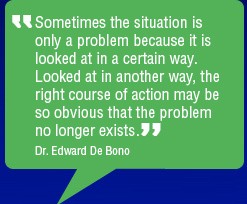6 Thinking Hats
Human thinking is unstructured and obscure, mind is always wavering and full of doubts. When group decisions are to be made it becomes all the more difficult as each person is on different level and has a different perspective and a different wavelength hence each person reinforces a problem in a different way. When different people need to make decision on a problem organizations get unexpected results. The thinking hat is a metaphor that represents each thinking direction as the hats can be easily put on and taken off. The six thinking hats introduced the thinking process to follow specific directions when necessary. Six Thinking Hats is a decision making tool designed by Edward de Bono which is useful in group discussion and also in individual decision making. The six hats coloured in six colors and are associated with the idea of parallel thinking. Parallel thinking provide a means for groups to plan thinking processes in a detailed and unified way, and in doing so, to think together more effectively.
The basis of this tool is that the human brain thinks in a number of distinct ways which can be consciously challenged, and hence planned for use in a structured way allowing one to develop tactics for thinking about particular issues. De Bono identifies six directions in which the brain can be challenged. In each of these directions the brain will identify and bring into conscious thought certain aspects of issues being considered for example, gut feeling, instinct, pessimism, judgement, neutral facts etc. None of these directions are natural ways of thinking, but they show a gist of how each person has a thinking pattern. Since the hats do not represent natural modes of thinking, each hat must be used for a limited time only. Also, many will feel that using the hats is peculiar, rough or even counterproductive way might improve their judgement. Some may find wearing a particular hat leading to ambiguity in decision making.
In a corporate meeting some people look at a problem as a small, easily solvable problem; while some might see serious clichés in it. Blue Hat sees the complete big picture, the goals and objectives with clarity; blue hat represents clarity in thoughts. Red Hat looks at problems using intuition, gut reaction, and emotion. The Red hat represents people with feelings and emotions. People often do not understand the reasoning behind the sensitive person’s recommended solutions. The red hat people have reactions full of feelings to a given problem. Wearing a White Hat represents objectivity; disseminating available data, using information on hand and determining the outcome. White Hat people use information effectively. They need all statistical data, spread sheets, previous reports for decision making. They look for knowledge gaps, and either fill them or assess the risk associated with them.
Black Hat thinkers are serious tinkers. They look at negative aspects of decision making. They look at everything very objectively and defensively. They assess the decision in regards to why it would work and more so why it might not work. This is important because it highlights the weak points in a plan. Black Hat thinking helps to eliminate the flaws, alter them, or prepare contingency plans to minimize their impact. It is always better and cheaper to fail on paper than in the market. Black Hat thinkers prepare others in the group to think cautiously. Yellow Hat thinkers are positive thinkers. They have a creative streak in them that allows one to see all the benefits of the decision and the value in it. They can easily think creative solutions. For them benefits need to be tangible and specific. Sometimes ideas might be unattractive but the concept behind it might have its weightage this is observed by the yellow hat thinkers. Green Hat thinkers stir the work atmosphere with their creativity and innovative thinking. Green Hat thinking gives solutions for a problem; they look at possibilities, options, ideas and choices. It gives solutions for doing things in new way.
In a meeting we see each participant’s approach differently. Because everyone is focused on a particular approach at any one time, the group tends to be more collaborative when each participant gives his/her inputs. If one person is reacting emotionally (Red hat) while another person is trying to be objective (White hat) and still another person is being critical of the points which emerge from the discussion (Black hat), somebody has creative solution (Green Hat). Each of these hats aid the group’s perspective. Each individual addresses problems from a variety of angles. An individual might or might not be able to focus with a full-fledged approach in solving the problem. The concept of six thinking hats helps organization to develop leadership as the group listens to each other’s point of view. Team Productivity increases as each participant’s view point gets aligned with the group objectively. It helps people to think innovatively. It strengthens decision making. Product and processes Improve. Changes in organization can be tackled easily. Change management becomes easy. Performance bar can be raised high.
In today’s complex business environment organizations need to think on so many multifarious decisions in some complicated situations; at many such times the managers need a way to increase their odds of success and minimize the probability of a poor decision. Six thinking hats has a 360-degree approach which motivates a person to think outside his/her repetitive thinking style, and facilitates a more healthy valuation of a situation.
Many successful people think from a very rational, positive viewpoint. Rational thinking is easily understood and conclusions are generally well accepted. But, we rarely get the comfortable situation for making rational decisions. In many cases, our thought process fails to look at a problem from an emotional, intuitive, resourceful viewpoint. Does this mean that rational decision makers underrate conflicting viewpoints? Six thinking hats does allow creative leaps and essential contingency plans. Similarly when pessimistic people tend to become defensive in many situations, driven by emotion alone, they fail to look at decisions calmly and rationally. When individuals and groups assess a problem with the ‘Six Thinking Hats’ technique, they can look at a situation or a problem through all possible lenses, thus allowing them to look at problems with effective blend of drive, skill in execution, public sensitivity, creativity and good contingency planning.
The German Federal Ministry for Economic Cooperation and Development (BMZ) employed the six hat methodology in their support to Sri Lankan government’s attempts to improve the planning and implementation of post-tsunami housing and reconstruction efforts. To this end, Sri Lankan and German counterparts cooperated in a series of joint project planning sessions which began with ‘six thinking hats sessions’. These sessions were used to identify and generate mutual understanding of the key issues which needed to be better understood and addressed in the reconstruction process.
When an individual wants to ensure that what he/she is considering, whether everything is relevant, the person can wear each hat in a sequence blue – red – yellow – black – white – green, to gauge all spears and try to produce thoughts of that kind. If two contrasting thoughts pop up under the one hat, that is fine, both of them can be weighed simultaneously and the contradiction may be resolved.
















































